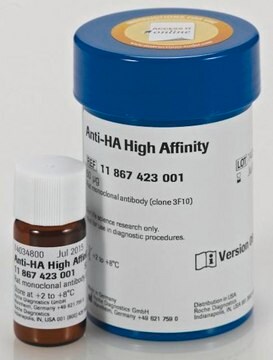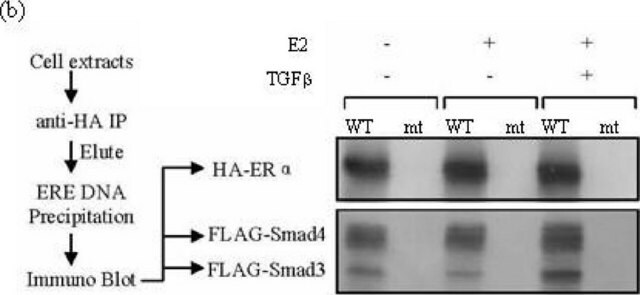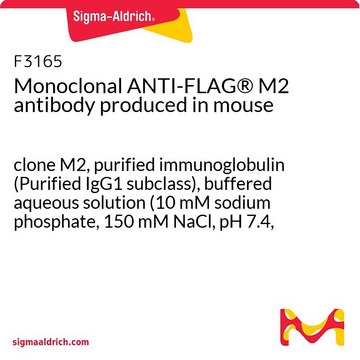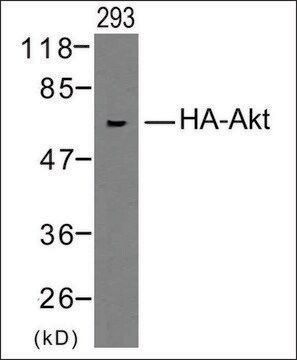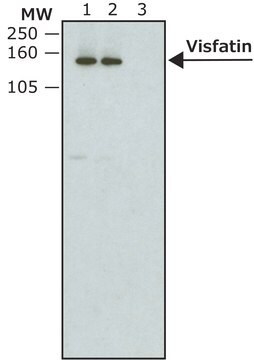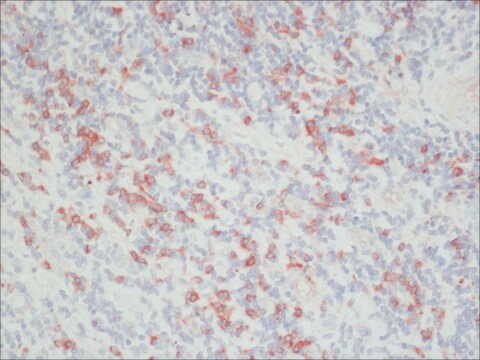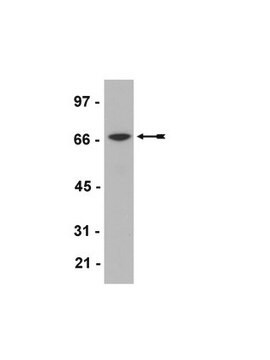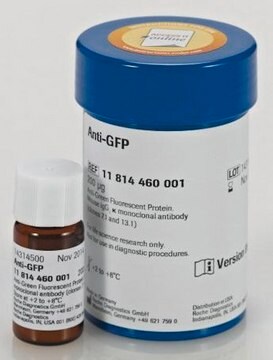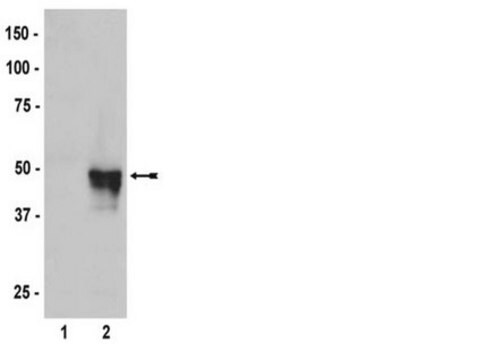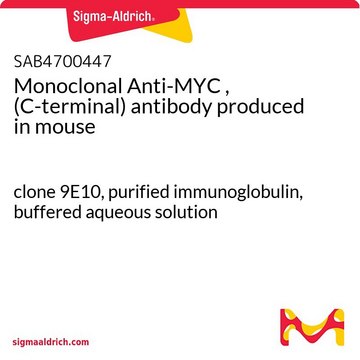12013819001
Roche
Anti-HA-Peroxidase, High Affinity
from rat IgG1
Sinonimo/i:
antibody
Autenticatiper visualizzare i prezzi riservati alla tua organizzazione & contrattuali
About This Item
Codice UNSPSC:
12352203
Prodotti consigliati
Origine biologica
rat
Livello qualitativo
Coniugato
peroxidase conjugate
Forma dell’anticorpo
purified immunoglobulin
Tipo di anticorpo
primary antibodies
Clone
clone 3F10, monoclonal
Stato
lyophilized (clear, colorless solution after reconstitution)
Confezionamento
pkg of 25 U (25 μg)
Produttore/marchio commerciale
Roche
Isotipo
IgG1
Sequenza dell’epitopo
YPYDVPDYA
Temperatura di conservazione
2-8°C
Categorie correlate
Descrizione generale
Anti-HA-Peroxidase, High Affinity is a monoclonal antibody to the HA-peptide (clone 3F10), conjugated to peroxidase.
Specificità
Anti-HA-Peroxidase, High Affinity (3F10) recognizes the 9-amino acid sequence YPYDVPDYA, derived from the human influenza hemagglutinin (HA) protein.
This epitope is also recognized in fusion proteins regardless of its position (N-terminal, C-terminal or internal).
This epitope is also recognized in fusion proteins regardless of its position (N-terminal, C-terminal or internal).
Immunogeno
The epitope consists of amino acids 98-106 from the human influenza virus hemagglutinin protein.
Applicazioni
- Use Anti-HA-Peroxidase, High Affinity for the detection of HA-tagged recombinant proteins using: ELISA
- Western blot
Nota sulla preparazione
Stabilizers: proteinaceous stabilizers
Working concentration: The working concentration of conjugate depends on application and substrate.
The following concentrations should be taken as a guideline:
Working concentration: The working concentration of conjugate depends on application and substrate.
The following concentrations should be taken as a guideline:
- Dot blot: 50 mU/ml
- ELISA: 25 mU/ml
- Western blot: 50 mU/ml
Ricostituzione
Add 1.0 ml double-distilled water for a final concentration of 25 U/mL.
Rehydrate for 10 min prior to use.
Rehydrate for 10 min prior to use.
Altre note
For life science research only. Not for use in diagnostic procedures.
Non trovi il prodotto giusto?
Prova il nostro Motore di ricerca dei prodotti.
Avvertenze
Warning
Indicazioni di pericolo
Consigli di prudenza
Classi di pericolo
Skin Sens. 1
Codice della classe di stoccaggio
11 - Combustible Solids
Classe di pericolosità dell'acqua (WGK)
WGK 1
Punto d’infiammabilità (°F)
does not flash
Punto d’infiammabilità (°C)
does not flash
Scegli una delle versioni più recenti:
Possiedi già questo prodotto?
I documenti relativi ai prodotti acquistati recentemente sono disponibili nell’Archivio dei documenti.
I clienti hanno visto anche
Asim A Beg et al.
Neuron, 55(5), 768-778 (2007-09-06)
The assembly of neuronal networks during development requires tightly controlled cell-cell interactions. Multiple cell surface receptors that control axon guidance and synapse maturation have been identified. However, the signaling mechanisms downstream of these receptors have remained unclear. Receptor signals might
Rokusuke Yoshikawa et al.
Microbiology and immunology, 60(6), 427-436 (2016-05-20)
Mammals have co-evolved with retroviruses, including lentiviruses, over a long period. Evidence supporting this contention is that viral infectivity factor (Vif) encoded by lentiviruses antagonizes the anti-viral action of cellular apolipoprotein B mRNA editing enzyme catalytic polypeptide-like 3 (APOBEC3) of
Jochen Klucken et al.
FASEB journal : official publication of the Federation of American Societies for Experimental Biology, 20(12), 2050-2057 (2006-10-03)
Oligomerization and aggregation of alpha-synuclein molecules are believed to play a major role in neuronal dysfunction and loss in Parkinson's disease (PD) and dementia with Lewy bodies. However, alpha-synuclein oligomerization and aggregation have been detected only indirectly in cells using
Michael Röring et al.
The EMBO journal, 31(11), 2629-2647 (2012-04-19)
The dimerisation of Raf kinases involves a central cluster within the kinase domain, the dimer interface (DIF). Yet, the importance of the DIF for the signalling potential of wild-type B-Raf (B-Raf(wt)) and its oncogenic counterparts remains unknown. Here, we show
Regina Gratz et al.
The New phytologist, 225(1), 250-267 (2019-09-06)
The key basic helix-loop-helix (bHLH) transcription factor in iron (Fe) uptake, FER-LIKE IRON DEFICIENCY-INDUCED TRANSCRIPTION FACTOR (FIT), is controlled by multiple signaling pathways, important to adjust Fe acquisition to growth and environmental constraints. FIT protein exists in active and inactive
Il team dei nostri ricercatori vanta grande esperienza in tutte le aree della ricerca quali Life Science, scienza dei materiali, sintesi chimica, cromatografia, discipline analitiche, ecc..
Contatta l'Assistenza Tecnica.